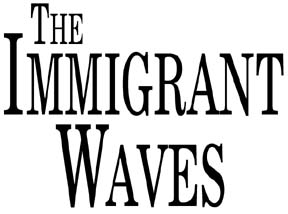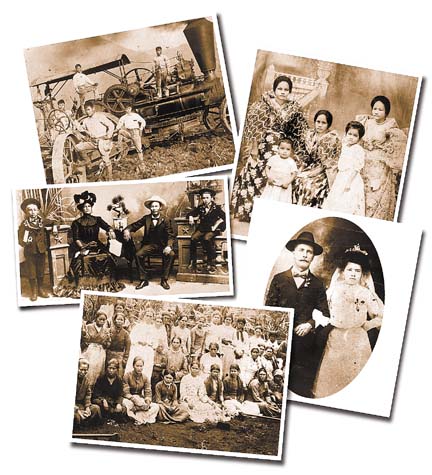


he determination of Hawaii's new land barons to grow sugar into the new isle economy. From whence we came...
The need for overseas field laborers, to supplement the native Hawaiians dying from foreign diseases.
The California gold rush, causing a population boom on the West Coast.
And the 1876 Reciprocity Treaty, which allowed Hawaii sugar to be imported duty-free to the United States.
These were the main factors that led Hawaii's territorial government to bring in immigrant laboers en masse.
Starting with Hawaii's Act for the Government of Masters and Servants in 1850, laborers could come into Hawaii as five-year plantation apprentices. When the Reciprocity Treaty skyrocketed the demand for sugar, however, so went immigration.
A glance at the early migrant waves, according to "The Peopling of Hawaii" by Eleanor Nordyke and immigration records at the Hawaii State Archives:
The Chinese
The early settlers came individually as crew members aboard British and American ships.But after Hawaii passed its servants act in 1850, some 200 Chinese men became the first organized shipment here, leaving behind homeland turmoil in 1852 to board the Thetis. They earned free passage, $3 a month, room and board -- in exchange for a five-year labor contract.
When their contract was up, many merged into the community -- and soon were accused of gambling, sex and crime as well as bringing leprosy, smallpox and opium use.
Between 1866 and 1884, according to Nordyke, Chinese in Hawaii grew from 1,200 to 18,000-plus.
Those factors, plus the lopsidedness of males to females, spurred Hawaii's Cabinet Council in 1883 to restrict Chinese immigration to 2,400 per year.
Tens of thousands Chinese left over the next 20 years. And when Hawaii became a territory in 1900, Chinese labor was banned with some exceptions.
It wasn't until 1943's repeal of the 1882 U.S. Chinese Exclusion Act that the Chinese population saw moderate growth here.
The Japanese
While the first Japanese here were believed to have been shipwrecked sailors, the first contract laborers of 140 men, six women and two children came in 1868.Under a new labor treaty, immigrants in the 1880s got three-year contracts that included $9 monthly pay for men, $6 for women; food allowance; board; medical care; plus rice capped at 5 cents per pound.
By 1900, Japanese were the largest ethnic group, nearly 40 percent of Hawaii's population -- their numbers had swelled from 116 in 1884, to 61,110.
Then from 1900 to 1924 came some 20,000 Okinawans; and from 1907 on, came the Japanese "picture brides."
The Portuguese
The Planters Society, predecessor to the Hawaii Sugar Planters Association, secured workers from Madeira and the Azores. Unlike the single men from China, the Portuguese laborers' contracts included wives and families, which provided more stability. Between 1878 and 1887, ships brought nearly 12,000 Portuguese here.A second wave was recruited in 1906-1913.
When Hawaii became a territory, U.S. laws which banned Asians from becoming citizens caused Hawaii to look to Portugal and Spain. Enhanced deals included land, a house and better working conditions. The Portuguese became the lunas -- plantation foremen -- and settled here, while Spaniards generally moved on to California.
The Germans
It was H. Hackfeld & Co., predecessor to Amfac, that recruited the German immigrants. Between 1881 and 1897, some 1,400 came and thrived under the Kauai plantation's paternalistic structure.
The Filipinos
U.S. acquisition of the Philippines after the Spanish-American War of 1898, coupled with Hawaii's status as a U.S. territory two years later, opened the door for Filipino immigration. This was encouraged by Hawaii's plantation managers who wanted to even out labor cliques to stem the rising power of organized Japanese workers.The first group of 160 Filipino laborers came in 1906 and by 1930, their numbers had grown to 100,000. Some 90 percent were Ilocanos from northern Luzon and Ilocos Sur.
But illiteracy plagued these people, and the Great Depression brought further problems, causing some two-thirds return to the Philippines. Post-WWII renewed interest in Philippines labor and today, Filipino immigrants with Hawaii family are among the fastest growing ethnic groups here.
Puerto Ricans and Blacks
In 1900-1901, some 5,200 Puerto Ricans came to Hawaii from their hurricane-ravaged homeland; more than half of these immigrants were the family members of male laborers.Records show blacks first came here as ship crew members, with a small number of black Portuguese arriving aboard whaling ships from 1820-1880. The Census classified these Blacks as Portuguese or part-Hawaiian, since many wed Hawaiians.
The Puerto Ricans who came in 1901 were a mix of black, native American or Spanish descent. Because blacks didn't solidify here as an ethnic block, the Census back then counted them as Puerto Ricans. It was the burgeoning military presence at the start of this century that drew black families here.
The Koreans
Between 1903 and 1905, some 7,000 Koreans, mostly male, arrived, lured by $16 monthly wages. Many of these recruits were converted to Christianity.Unlike early workers, Koreans were not indentured laborers so could work on plantations or elsewhere in Hawaii.
These immigrants and their second- and third-generations Americanized quickly. Later, when immigration laws relaxed in 1965, Hawaii saw another wave of immigrants from Korea.
The Honolulu Star-Bulletin is counting down to year 2000 with this special series. Each month through December, we'll chronicle important eras in Hawaii's history, featuring a timeline of that particular period. Next month's installment: August 9. About this Series
Series Archive
Project Editor: Lucy Young-Oda
Chief Photographer: Dean Sensui